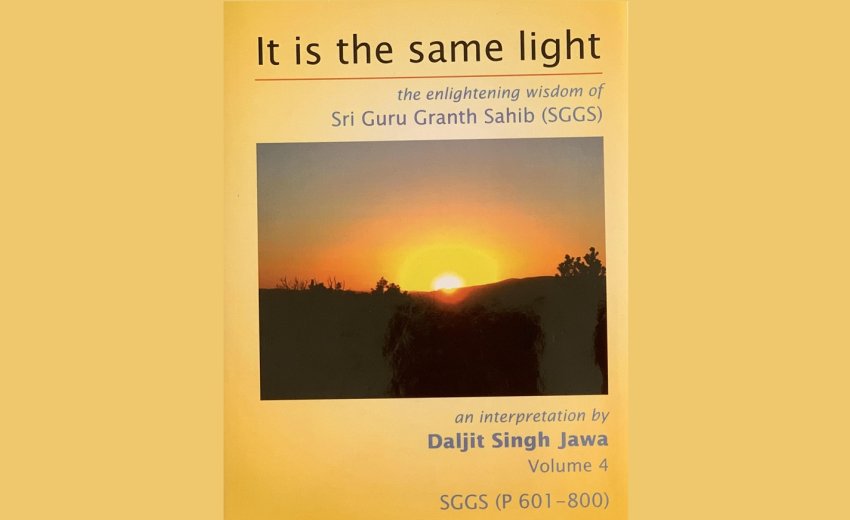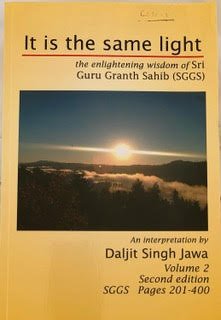We all know that the teachings of the Gurus are universal and are meant for all of human kind.
The famous agnostic, intellectual and Nobel Prize awardee (for literature) Bertrand Russell famously made statements that of all religions the teachings of Sikhi hold the most promise for guiding humanity.
However, one issue that arises when reading translations is the lack of context. Because Gurbani is multi-layered, full of analogies and poetic imagery not all of it lends itself easily to English translation. The English reader generally gets the idea being conveyed but is too often left wanting for a full understanding. Here now is another translation in English that has been produced by U.S. based Daljit Singh Jawa that reads as a study guide of the Guru so that the analogies can be put into context and the message can be fully understood. The translation, titled 'It Is The Same Light" is in seven volumes and covers the entire Guru Granth Sahib. The giant work of Jawa has born fruit; below is the testimony from a reader who had given up on religion but found this work intellectually engaging and spiritually inspiring. Jesse Schell from New Zealand would otherwise have nothing to do with Sikhi but as you read below he found it resonated with him (note that all the volumes weren't available to Mr. Schell when he wrote the following but they are now):
Jesse Schell, A non-Sikh from New Zealand
Disclaimer: I am not a Sikh by their definition. I am a 62 year old westerner, brought up in the scientific West. I have spent almost my entire life seeking sane and logical spirituality but have been disappointed by all the religions I've studied from atheism to Zoroastrianism; I have finally come to the place of humanism.
A year ago I came across the Sikh scripture called Guru Granth Sahib (GGS). I couldn't believe my luck and I began my study of Sikhism. This scripture is over 500 years old and was written in a variety of different languages and dialects, in a poetry style. This makes translation difficult. There are a few translations into English but most of them are in archaic English or the language and grammar is incorrect. Mr. Jawa has presented us with his translation and interpretation of the GGS.
The positives of this work are:
1. Each page is linked to its corresponding page in GGS for easy reference.2. The original text is presented in both the original language in Gurmukhi script with the transliteration in Roman script.
3.The translation is clear and crisp in modern English and with correct grammar. The translation is not literal or forced but is natural and enticing.
4. All the translator's notes which are to clarify any text are clearly identified so it's easy to tell them from the translation of the original GGS text. There are no distracting footnotes.
5. The author links the preceding section with the new section and then gives a brief summary at the end of each section. The former is very helpful; the latter is a bare bones commentary just repeating tired conservative thinking.
6. This author uses inclusive pronouns for people but unfortunately still uses the masculine form when referring to God.
7. The author does stretch some established boundaries in the way he has translated and I appreciate that effort.
8. This is a lot like a study version.
Of all the English translations of the GGS I've seen so far, this is by far the one that I like to read. I can't read the original text in Punjabi (and neither can many Sikhs!) so I can't judge the accuracy of the translation. But I do know that when I read Mr. Jawa's work, something resonates inside me and I want to go deeper into the scripture. I believe it's the way he has done the translation which is not poetic but not exactly totally prose either.
So far, two volumes are available with a promised third soon to be released. I can overwhelmingly recommend this translation of the Guru Granth Sahib for anyone who wants to read the GGS. Buy the hardcover edition; this is a book you'll read and study over and over again.
Now that the volumes are finished he has taken it upon himself to offer short digestable bites of his work through his YouTube channel: @hukamnama. Each video recites and translates a hukamana.
Interested persons can listen to the detailed or concise explanations of the daily Hukam Namas as per the Sikh Rehat Maryada (Sikh Code of Conduct), by clicking on the button “PlayLists” and by choosing the alphabetical or page wise listing.
The seven volumes are available on Jawa's website: https://www.gurbaniwisdom.com/
Daljit Singh Jawa has done a great seva for the Panth; We offer him many blessings and congratulations for his great seva.


